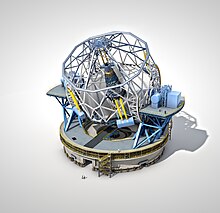European Extremely Large Telescope
European Extremely Large Telescope (E-ELT) bliver det indtil nu største teleskop på Jorden, og er under opførrelse på bjerget Cerro Armazones i Atacamaørkenen i Chile i en højde på 3.060 moh. Byggeriet påbegyndtes d. 27. maj 2017. Telskopets hovedspejl kommer til at have en diameter på 39,3 m sammensat af mindre spejle. Sekundærspejlet vil have en diameter på 4,2 m. Hovedspejlet vil komme til at fungere med adaptiv optik styret vha. seks kunstige laserskabte stjerner. Det forventes at være færdigbygget og testet i 2024, og skal herefter indgå som en del af ESAs Paranal-observatorie.
ESA forventer at benytte teleskopet til at lede efter exoplaneter (planeter om andre stjerner end Solen), herunder også at kunne tage billeder af de større exoplaneter, og muligvis også at kunne beskrive disses atmosfære. Desuden forventer man at kunne opdage vand og organiske molekyler i skiven omkring stjernedannelser. Viden om disse ting vil bidrage til at forstå de tidlige stadier i evolutionen.[1]
Se også
Kilder
THE EUROPEAN EXTREMELY LARGE TELESCOPE ("E-ELT") PROJECT Arkiveret 10. december 2019 hos Wayback Machine ESAs officielle hjemmeside (engelsk)
- ^ Are We Alone? Arkiveret 31. august 2017 hos Wayback Machine, European Southern Observatory, Hentet 2. sept. 2017 (engelsk)
| Spire Denne artikel om astronomi er en spire som bør udbygges. Du er velkommen til at hjælpe Wikipedia ved at udvide den. |
Koordinater: 24°35′21″S 70°11′30″V / 24.5893°S 70.1916°V
Medier brugt på denne side
Forfatter/Opretter: ESO, Licens: CC BY 4.0
The European Extremely Large Telescope (E-ELT), with a main mirror 39 metres in diameter, will be the world’s biggest eye on the sky when it becomes operational early in the next decade. The E-ELT will tackle the biggest scientific challenges of our time, and aim for a number of notable firsts, including tracking down Earth-like planets around other stars in the “habitable zones” where life could exist — one of the Holy Grails of modern observational astronomy.
The telescope design itself is revolutionary and is based on a novel five-mirror scheme that results in exceptional image quality. The primary mirror consists of almost 800 segments, each 1.4 metres wide, but only 50 mm thick. The optical design calls for an immense secondary mirror 4.2 metres in diameter, bigger than the primary mirrors of any of ESO's telescopes at La Silla.
Adaptive mirrors are incorporated into the optics of the telescope to compensate for the fuzziness in the stellar images introduced by atmospheric turbulence. One of these mirrors is supported by more than 6000 actuators that can distort its shape a thousand times per second.
The telescope will have several science instruments. It will be possible to switch from one instrument to another within minutes. The telescope and dome will also be able to change positions on the sky and start a new observation in a very short time.
The very detailed design for the E-ELT shown here is preliminary.

